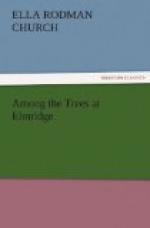“Are snakes ever pretty?” asked Edith, in great surprise.
“Certainly they are, dear, and this one had lovely stripes. I wish you could have seen him.”
The little girl began to wish so too, it was so funny to think of a snake being pretty, and she felt quite ashamed that she had scampered away in such a silly fashion.
“What a goose I was!” said Clara, doing her thinking aloud. “But I thought it must be something dreadful, when Edie screamed so.”
“How much better it would have been to have found out before you screamed!” replied Miss Harson.—“But come, Edith; see what a nice cane Malcolm has just cut to help your lame foot with. He is offering you his arm, too, on the other side, and between the two I think you will get along finely.”
Edith thought the same thing, and enjoyed being helped home in this fashion. Her foot was quite painful, though, and considerably swollen; and Clara bathed it with arnica when the little girl had been comfortably established on the schoolroom sofa.
“Perhaps,” said Miss Harson, “our little invalid will not care to hear about trees this evening?”
But the little invalid did care, and it was decided to take a further ramble among the birches.
“I want to hear about birch-bark,” said Malcolm—“not the kind we’ve been eating, but the kind that canoes and things are made of.”
[Illustration: THE CUT-LEAVED WHITE BIRCH.]
“You have already heard about the black birch,” replied his governess, “and, besides this, we have the white, or gray, birch, the bark of which is white, chalky and dotted with black; the red birch, with bark of a reddish or chocolate color; the yellow birch, bark yellowish, with a silvery lustre; and the canoe birch, which has a white bark with a pearly lustre. There is also a dwarf, or shrub, birch. The list, you see, is quite a long one.”
“What kind grow in our woods?” asked Clara.
“You certainly know of one kind,” was the reply—“the black, or sweet, birch, which we have all tried and like so well. Besides this, there is the white, or little gray, birch, which is seldom over twenty-five or thirty feet high. It is, however, a graceful and beautiful object, enjoying to an eminent decree the lightness and airiness of the birch family, and spreading out its glistening leaves on the ends of a very slender and often pensile spray with an indescribable softness. An English poet has called this tree the
“’most
beautiful
Of forest-trees, the
lady of the woods.’”
The children laughed at the idea of calling a tree a lady, it seemed so comical; but Miss Harson said that she thought this was a very good description of a slender, graceful tree.
[Illustration: WHITE-BIRCH LEAF.]




